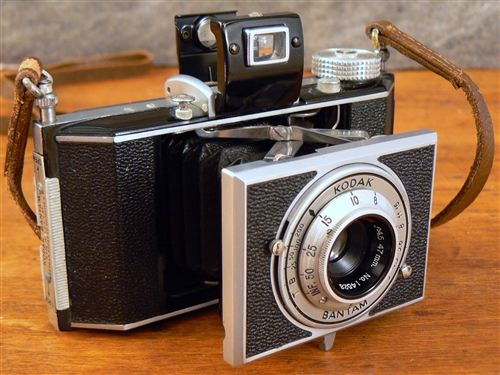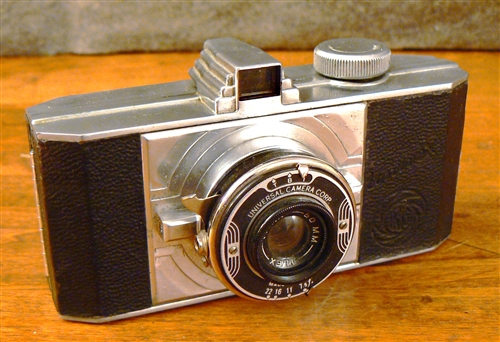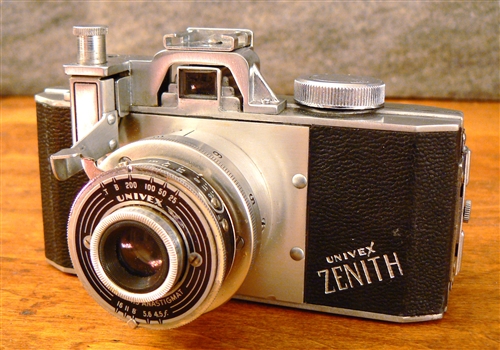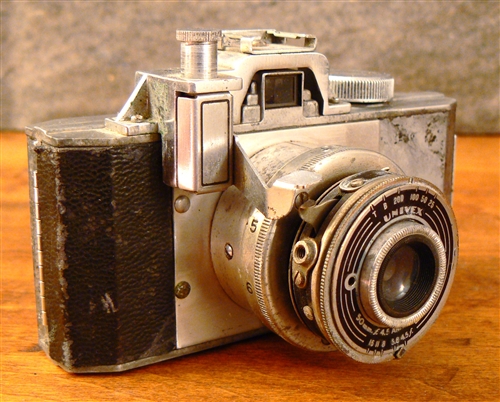
Here's the whole Iris line - note the massive flashbulb on the Zenith!
In 1938, a lot of things were happening at the Universal Camera Corporation. The company had entered the “Vest Pocket Camera” market just about the time that the craze for small folding cameras was coming to an end. Sales were falling off for both the UniveX Model A and the Model AF Folding Cameras, because many buyers of those cameras were progressing to more feature-laden designs with lens opening and shutter speed adjustments – features not available in the current UniveX product line. As the simple cameras fell into disuse, sales of “00” film were also dropping, and the need for a new product to reinvigorate film sales was apparent.

The competition: the Kodak Bantam, though a folder, was an early candid camera with full focusing and exposure controls
Therefore, the next step in their product development plan involved a rigid-bodied camera with a collapsible lens, with both f-stop and shutter speed adjustments. Cameras of this type were then generally known as candid cameras. Cameras of this type available at the time included Kodak’s Bantam and Kodak 35, the German Leica and Contax (for those with lots of bucks), and Argus’ Models A, AF, and B. From a price standpoint, the Argus cameras were the real competition. They offered a simple fixed focus model with adjustable lens openings and shutter speeds, a scale-focusing model with the aforementioned features, and one with all of the above plus a built-in extinction meter.
Universal’s plan was to cut costs and create a low-priced candid camera product line that ran the gamut from simple to sophisticated. They created a zinc die-cast body as a base for all the models, then designed a progrssively more full-featured line of products based on the original platform.
Iris Standard Candid Camera

The Iris Standard Candid Camera (non-flash sync model)
The base model was christened the Iris Standard Candid Camera, and had a fixed-focus collapsible lens, f-stops from f/7.7 to f/22, and a simple T,B, & I shutter. The zinc body had a black crinkled enamel finish, chrome lens barrel, and a satin-chrome front panel around the lens mount. An optical viewfinder sat atop the body.
Iris Deluxe Candid Camera

The Iris Deluxe Candid Camera (non-flash sync model)
The Iris Deluxe Candid Camera was more ornate, sporting a satin chrome finished body, and a black leatherette covering with the Iris logo stamped in white. Initially, both cameras had identical features, then after about two months of production, the Deluxe model was fitted with a scale-focusing lens. All Iris Deluxe models thereafter had a focusing lens, so fixed-focus Deluxes are uncommon.
Zenith Candid Camera

The Zenith Flash Candid Camera (with flash synchronizer)
The top-of-the-line UniveX candid camera was called the Zenith. Aimed at serious amateur photographers, the Zenith had a die-cast aluminum alloy body, micrometer-focusing (non-collapsing) 50mm f/4.5 anastigmatic lens with 5 f-stop settings, shutter speeds of 1/25-1/200 second plus T & B, and optional flash synchronization. Flash synchronization was offered on all lesser Iris models at around the same time. The Zenith had a black leatherette covering, silver-stamped Zenith logo on the front of the camera body, satin chrome finish on all metal parts, and an optional eveready case.
Hitler screws up a great marketing plan
These cameras all used Universal’s “00” rollfilm, and were very successfully launched throughout 1938 (Iris Standard & Deluxe) and 1939(Zenith), restoring sales of UniveX “00” rollfilm and dramatically improving the company’s bottom line. The Zenith was the last model to be introduced, during the last few months of 1939, just in time for Christmas. Sales were substantial, and life was good. Then Hitler invaded Poland, and that was only the beginning. As the German Army rolled through the German-speaking countries of Europe, Gevaert Company, the sole supplier of film to Universal, became unable to ship film from their own plants in Belgium late in 1939, and by spring of 1940, Belgium was occupied by the German Army. Universal frantically tried to find another source of film, with no success. It wasn’t until mid-1940 that Gevaert succeeded in building and starting up a film plant in the U. S., and for months afterward, UniveX film was scarce, even unavailable in most of the country.
As a result of this situation, people who received new UniveX Zenith Candid Cameras for Christmas were greeted with the news that film was not to be found. Many, if not most, of these cameras were tossed in the trash as worthless. As the most advanced camera designed to use the “00” rollfilm, the Zenith had been built in reduced numbers compared to the Irises to begin with. The fact that the Zenith production run ended during the crisis resulted in a real scarcity of Zeniths to the camera collecting population. It is regarded as the rarest of all UniveX camera models. So I have Hitler to thank for the rarity and consequent value of my Zenith Flash Candid Camera.
Strange footnote: when I started to prepare the photos of my Iris Series cameras for this post, I dragged everything out of storage, including an old decrepit camera that I bought as part of a box lot ages ago. I had cataloged it as an Iris Deluxe model, but the leatherette was missing from most of the body, and it was really in rough shape. As I went over the cameras I needed to photograph, I realized that the “Iris Deluxe” was actually another Zenith. This may not amaze you, but I looked for nearly five years with great diligence to find my first Zenith (bought it on ebay, of course), and I’d be ashamed to tell you what I paid for it. In the eight years since then, I’ve never seen another specimen anywhere, in any condition. And I just found one in my own collection….

It's ugly, but it's a Zenith! I'll be polishing, restoring and re-covering this baby in the near future.

I love old cameras! My mom found an old camera that used to belong to my late grandpa a few weeks ago and she bestowed it to my brother-in-law, who’s a photographer, and he was over the moon about it. I’m loving this blog. xo
I have a Univex Zenith in excellent condition that still works! Also have this Iris model in my collection. Any idea with the Zenith may be worth today?
hi I was fortunate to look for your blog in baidu
your post is excellent
I obtain a lot in your subject really thanks very much
btw the theme of you blog is really fine
where can find it
Dana,
I came across a 8mm film projector. It is a Universal Camera Corporation Cinematic model P-750. I tried researching it, but I could only find info on the P-752. I was wondering if you could tell me anything about it.